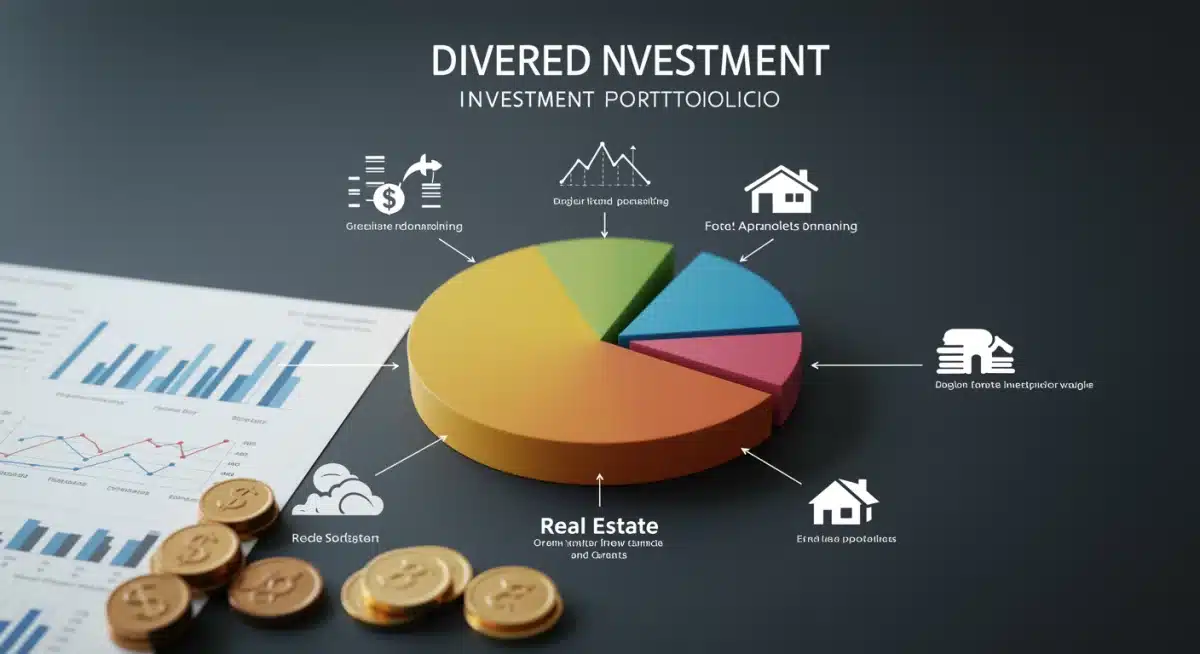Adapt Investment Strategy to 15% Market Volatility

Navigating the prevailing 15% market volatility demands a proactive and adaptable investment strategy, encompassing diversification, robust risk assessment, and a clear long-term perspective to safeguard and potentially enhance portfolio growth.
The financial markets are currently experiencing a significant period of flux. Investors are grappling with increased uncertainty as we observe a 15% market volatility in recent weeks. This immediate shift necessitates a strategic re-evaluation of current portfolios to protect assets and identify potential growth opportunities.
Understanding the Current Market Volatility
The current market environment is characterized by a notable 15% volatility, as reported by leading financial indexes as of [Current Date]. This heightened unpredictability stems from a confluence of global economic factors, geopolitical tensions, and evolving corporate earnings reports. Investors must first comprehend the underlying drivers to effectively adapt their investment strategy.
Recent data indicates that inflation concerns, coupled with central bank policy adjustments, are key contributors to the market’s swings. Supply chain disruptions, though easing in some sectors, continue to exert pressure on corporate profitability, further fueling investor apprehension. Understanding these dynamics is crucial for making informed decisions in a swiftly changing landscape.
Key Drivers of Recent Market Swings
- Inflationary Pressures: Persistent high inflation rates are eroding purchasing power and prompting aggressive monetary policy tightening.
- Geopolitical Developments: Ongoing international conflicts and trade disputes introduce significant uncertainty, impacting global supply chains and commodity prices.
- Interest Rate Hikes: Central banks globally are raising interest rates to combat inflation, which can dampen economic growth and corporate earnings.
- Energy Price Fluctuations: Volatile energy markets directly affect production costs and consumer spending, adding another layer of complexity.
Reassessing Your Risk Tolerance and Investment Goals
In periods of 15% market volatility, a fundamental step for any investor is to reassess their personal risk tolerance. What felt comfortable during stable periods might now feel overly aggressive or too conservative. This introspection is vital for aligning your portfolio with your comfort level and financial objectives.
Reviewing your investment goals is equally important. Have your short-term or long-term objectives shifted due to recent life events or changes in your financial situation? Understanding these updated goals will dictate how aggressively or cautiously you should adapt your investment strategy. A mismatch between risk tolerance and investment goals can lead to emotional decisions, often detrimental to long-term returns.
Defining Your Updated Risk Profile
Your risk profile isn’t static; it evolves with market conditions and personal circumstances. During periods of heightened volatility, it’s essential to determine if your current portfolio allocation still reflects your true capacity and willingness to take on risk.
- Capacity for Risk: This refers to your financial ability to withstand losses without significantly impacting your lifestyle or future plans.
- Willingness to Take Risk: This is your psychological comfort level with potential fluctuations and losses in your investments.
- Time Horizon: A longer time horizon typically allows for greater risk-taking, as there is more time to recover from downturns.
Diversification as a Core Strategy Amidst Volatility
Diversification remains a cornerstone of sound investment planning, especially when confronting a 15% market volatility. Spreading investments across various asset classes, industries, and geographies can significantly cushion the impact of downturns in any single area. This strategy is not about avoiding all risk, but rather managing and mitigating it effectively.
A well-diversified portfolio aims to ensure that while some assets may be underperforming, others might be holding steady or even growing. This balance helps to smooth out overall portfolio returns during turbulent times. It prevents over-reliance on any one segment of the market, which could be particularly vulnerable to current economic pressures.

Implementing Effective Diversification
Effective diversification goes beyond simply owning multiple stocks. It involves a thoughtful allocation across different types of investments that react differently to market forces. This can include a mix of equities, fixed income, commodities, and alternative investments.
- Asset Class Diversification: Include a mix of stocks, bonds, and possibly real estate or commodities. Bonds often act as a buffer during equity market downturns.
- Geographic Diversification: Invest in companies and markets across different countries to reduce exposure to regional economic risks.
- Sector Diversification: Spread investments across various industries (e.g., technology, healthcare, consumer staples) to avoid overconcentration in one sector.
- Investment Style Diversification: Consider a mix of growth, value, and income-generating investments.
Considering Defensive Assets and Income Generation
In a period marked by 15% market volatility, shifting some focus towards defensive assets and income-generating investments can provide much-needed stability. Defensive assets are typically less sensitive to economic cycles and tend to perform relatively better during downturns. These can include sectors like utilities, consumer staples, and healthcare.
Furthermore, investments that provide a steady stream of income, such as dividend-paying stocks or high-quality bonds, can offer a buffer against capital depreciation. This income can be reinvested or used to offset losses, contributing to overall portfolio resilience. The goal is to create a more stable foundation for your portfolio during uncertain times.
Identifying Stable Income Streams
Focusing on investments that consistently generate income can be a strategic move when market growth is unpredictable. These assets can help maintain portfolio value and provide liquidity.
- High-Quality Dividend Stocks: Companies with a long history of paying and increasing dividends often demonstrate financial stability.
- Investment-Grade Bonds: Government bonds and highly-rated corporate bonds can offer predictable interest payments and lower volatility compared to equities.
- Real Estate Investment Trusts (REITs): REITs can provide steady income through rental payments, though they are also subject to market fluctuations.
Dollar-Cost Averaging and Long-Term Perspective
Maintaining a long-term perspective and employing strategies like dollar-cost averaging are particularly potent during periods of 15% market volatility. Dollar-cost averaging involves investing a fixed amount of money at regular intervals, regardless of market fluctuations. This approach helps to mitigate the risk of investing a large sum at an unfavorable market peak.
By consistently investing, you buy more shares when prices are low and fewer when prices are high, ultimately reducing your average cost per share over time. This systematic approach removes emotional decision-making from the investment process and aligns perfectly with a long-term strategy, allowing you to ride out short-term market turbulence.
The Power of Consistent Investing
Dollar-cost averaging is a disciplined approach that harnesses market fluctuations to your advantage. It requires patience and a commitment to your investment plan, even when headlines are alarming.
- Reduces Market Timing Risk: You don’t need to predict market bottoms or tops; consistent investing averages out your entry points.
- Capitalizes on Downturns: When prices drop, your fixed investment buys more shares, positioning you for greater gains during recovery.
- Promotes Discipline: It encourages regular savings and discourages impulsive reactions to market news.
Rebalancing Your Portfolio Proactively
Proactive portfolio rebalancing is a critical task in an environment of 15% market volatility. Over time, market movements can cause your asset allocation to drift significantly from your original target. For instance, if equities have performed poorly, their proportion in your portfolio might have shrunk, making your portfolio more conservative than intended, or vice-versa.
Rebalancing involves adjusting your portfolio back to its target asset allocation by selling assets that have performed well and buying those that have underperformed. This disciplined approach ensures your portfolio continues to align with your risk tolerance and investment goals, preventing overexposure to certain assets and taking advantage of undervalued opportunities. It’s not about chasing returns but maintaining strategic alignment.
Steps for Effective Portfolio Rebalancing
Regularly reviewing and adjusting your portfolio is essential to staying on track, especially when market conditions are dynamic. This process involves a few key steps to ensure your strategy remains aligned with your financial objectives.
- Set a Review Schedule: Decide whether to rebalance quarterly, semi-annually, or annually. Consistency is key.
- Define Target Allocations: Clearly establish the desired percentage for each asset class based on your risk tolerance and goals.
- Identify Deviations: Compare current allocations to your targets and identify any significant drifts.
- Execute Trades: Sell overperforming assets and buy underperforming ones to restore target allocations.
Seeking Professional Financial Guidance
Navigating a market with 15% volatility can be complex, and seeking professional financial guidance is often a prudent decision. An experienced financial advisor can provide personalized insights, help you assess your risk profile accurately, and develop an investment strategy tailored to your specific circumstances and goals. They can offer an objective perspective, helping you avoid emotional pitfalls and make informed decisions.
A professional can also assist in identifying suitable investment vehicles, implementing diversification strategies, and ensuring your portfolio remains aligned with your long-term objectives. Their expertise is invaluable in translating complex market data into actionable steps that protect and potentially grow your wealth during uncertain times. As of [Current Date], many investors are actively engaging with advisors to refine their strategies.
Benefits of Expert Financial Advice
Working with a financial expert can offer numerous advantages, particularly when markets are volatile and decisions feel overwhelming. Their guidance can bring clarity and confidence to your financial planning.
- Personalized Strategy: Advisors create plans tailored to your unique financial situation, goals, and risk tolerance.
- Objective Perspective: They help you make rational decisions, free from emotional biases that often arise during market downturns.
- Market Insight: Professionals have access to in-depth research and analysis, providing valuable context for market fluctuations.
- Tax Efficiency: They can help structure your investments in a tax-efficient manner, maximizing your net returns.
| Key Strategy | Brief Description |
|---|---|
| Diversification | Spread investments across asset classes to mitigate risk during high volatility. |
| Risk Reassessment | Re-evaluate personal risk tolerance and adjust investment goals to current market conditions. |
| Dollar-Cost Averaging | Invest fixed amounts regularly to reduce average cost and minimize market timing risk. |
| Professional Guidance | Seek expert advice for personalized strategies and objective decision-making. |
Frequently Asked Questions About Market Volatility
A 15% market volatility indicates significant price swings, meaning your investments could experience rapid gains or losses. It highlights increased market uncertainty and the need for a carefully considered, adaptable investment strategy to manage risks effectively.
Panicking and selling all investments during high volatility is generally not recommended. This often locks in losses and prevents participation in subsequent market recoveries. Instead, focus on reassessing your strategy, diversifying, and maintaining a long-term perspective.
Diversification spreads your investments across various asset classes and sectors, reducing the impact of poor performance in any single area. This strategy helps cushion your portfolio during downturns, providing stability and potentially smoother overall returns amidst market swings.
Defensive assets are investments less sensitive to economic cycles, such as utilities, consumer staples, and high-quality bonds. They are important during high volatility because they tend to perform relatively better, offering stability and reducing overall portfolio risk when other sectors decline.
Yes, dollar-cost averaging is highly effective during current volatile market conditions. By investing a fixed amount regularly, you buy more shares when prices are low and fewer when high, averaging your cost and mitigating the risk of mistiming the market, which is crucial now.
What Happens Next
As the market continues to grapple with 15% volatility, investors should monitor key economic indicators such as inflation reports, interest rate decisions from central banks, and geopolitical developments. These factors will heavily influence market directions in the coming months. Expect continued short-term fluctuations, but also potential opportunities for strategic investors. The ability to remain agile and disciplined, adjusting portfolios based on evolving data rather than emotional reactions, will be paramount. Further adjustments in corporate earnings forecasts and consumer spending patterns are anticipated to shape the landscape, demanding ongoing vigilance and a readiness to adapt investment strategy.





